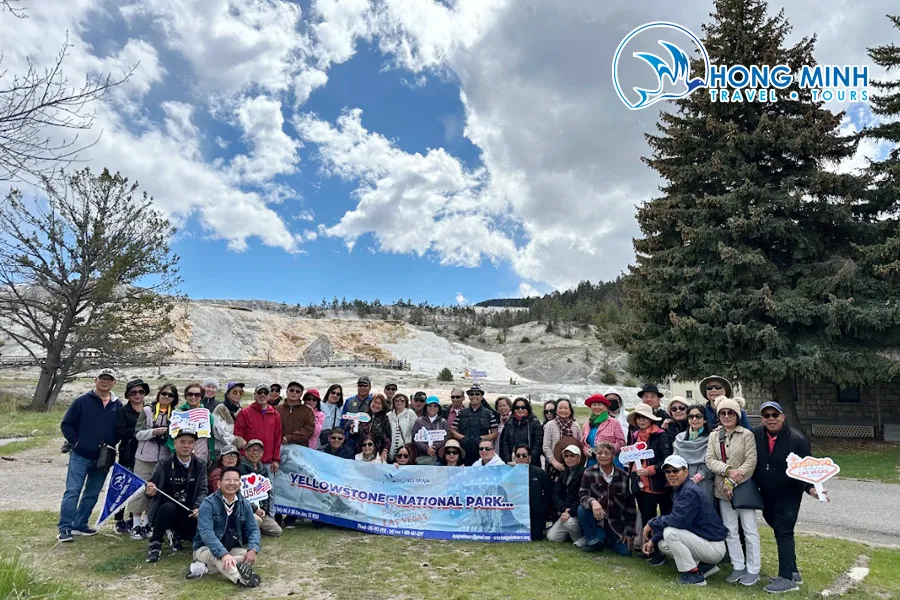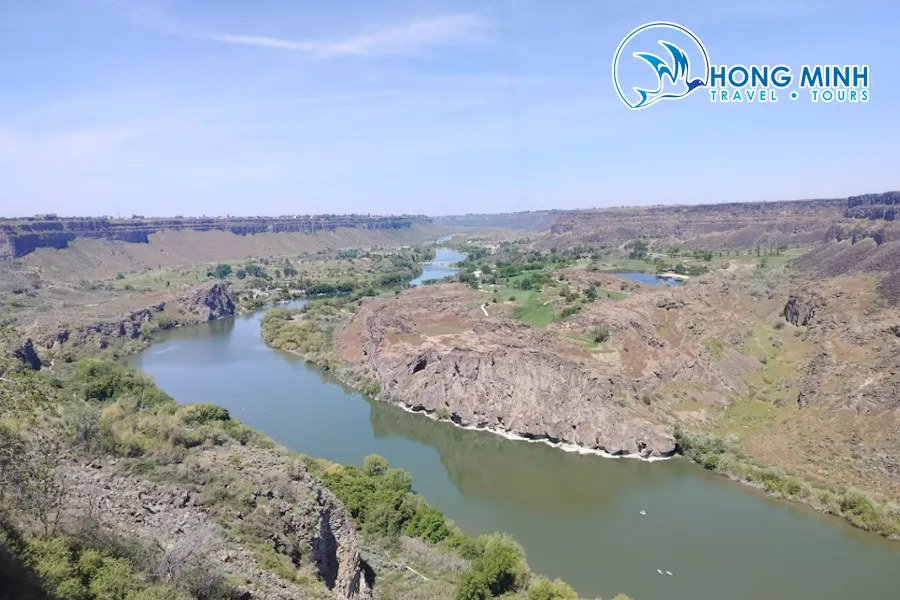Yellowstone, the name conjures images of a pristine, magnificent land with powerful geysers erupting, vividly colored hot springs, and boundless forests. But hidden beneath this splendid natural beauty lies a grand geological secret: Yellowstone Volcano, a supervolcano with latent power that could alter the entire planet. This article serves as a guide to understanding Yellowstone Volcano, helping you discover the wonders and mysteries of this unique geothermal marvel, not only a captivating tourist destination but also an invaluable natural laboratory for scientists.
Yellowstone – More Than Just a National Park
Yellowstone National Park, established in 1872, is the first national park in the United States and the world. Spanning nearly 9,000 km², Yellowstone stretches across three states—Wyoming, Montana, and Idaho—and encompasses a diverse and rich ecosystem. However, what makes Yellowstone truly special and attracts millions of visitors each year is not just its stunning natural landscapes but also the presence of a colossal geothermal system, originating from an active supervolcano beneath the surface.
Upon arriving in Yellowstone, you’ll be amazed by the unique geothermal wonders. Over 10,000 hot springs, geysers, mud pots, and fumaroles create a vibrant and colorful natural tapestry. Geysers like Old Faithful erupting regularly, sending towering columns of hot water into the sky, are the clearest evidence of Yellowstone Volcano’s hidden power. Hot springs like Grand Prismatic Spring, ablaze with rainbow hues, or Mammoth Hot Springs with its cascading white travertine terraces, are exquisite works of nature, formed by the interaction of hot water from the earth and minerals.

The Secret of the Yellowstone Supervolcano
To truly understand Yellowstone Volcano, we need to delve deep into the earth, exploring the vast magma system beneath the park. Yellowstone is not a typical cone-shaped volcano but a caldera, a massive volcanic crater formed after a colossal eruption. The Yellowstone Caldera measures approximately 55×85 km, indicating the immense scale of past eruptions.
Scientists have proven that Yellowstone is a supervolcano, capable of producing eruptions far greater than ordinary volcanoes. In Yellowstone’s million-year history, there have been at least three major supervolcanic eruptions, occurring approximately 2.1 million years ago, 1.3 million years ago, and 640,000 years ago. These eruptions released enormous amounts of ash and material, covering vast areas of North America and potentially affecting global climate.
What gives Yellowstone its supervolcanic power? The answer lies in the Yellowstone hotspot, a plume of hot mantle material rising from deep within the Earth’s mantle towards the surface. This hotspot provides a rich energy source to fuel the massive magma system beneath Yellowstone. When pressure in the magma system reaches a critical point, it can trigger a volcanic eruption.
Exploring Geothermal Wonders
Yellowstone’s unique geothermal phenomena are the “breaths” of the active volcano. Geysers are among Yellowstone’s most famous wonders. Groundwater seeps deep into the earth, is heated by magma, and pressure builds up in cracks. When the pressure is sufficient, hot water erupts to the surface as spectacular columns of water and steam. Old Faithful Geyser is the world’s most famous geyser, erupting on average every 90 minutes, attracting crowds of visitors to witness its spectacle.
Hot springs are pools of water heated by geothermal heat. The temperature of hot springs can be very high, even near boiling point. Hot springs contain many dissolved minerals, creating vibrant and unique colors. Grand Prismatic Spring is Yellowstone’s largest hot spring and the third largest in the world, renowned for its rainbow-like colors.
Mud pots are bubbling pools of mud, formed when hot water mixes with clay and other minerals. Gases and steam escaping from the ground create the characteristic gurgling sounds of mud pots. Fountain Paint Pot is a famous mud pot area in Yellowstone, with various mud pots of different colors and consistencies.
Fumaroles are vents releasing steam and volcanic gases from the earth. Gases escaping from fumaroles often contain sulfur, producing a distinctive rotten egg smell. Dragon’s Mouth Spring is a unique fumarole in Yellowstone, with steam erupting from a small cave, creating sounds like a dragon’s roar.

Wildlife and Unique Ecosystem
The influence of Yellowstone Volcano extends beyond geothermal phenomena to the park’s ecosystem and wildlife. The warm temperatures from hot springs create a unique habitat for many heat-loving microorganisms (thermophiles). These microorganisms play a crucial role in nutrient cycles and contribute to the unique colors of hot springs.
Yellowstone is also one of the largest wildlife preserves in the United States. The park is home to many rare animals such as grizzly bears, gray wolves, bison, elk, and numerous bird species. Diverse ecosystems ranging from pine forests and grasslands to geothermal areas create rich habitats for wildlife.
When exploring Yellowstone, visitors have the opportunity to observe wildlife in their natural environment. However, it’s crucial to maintain a safe distance and adhere to park regulations to ensure personal safety and protect wildlife. Yellowstone Bear World, a wildlife park near Yellowstone, is also an excellent option for safely and closely observing North American wildlife.
Volcanic Risks and Monitoring Efforts
Despite Yellowstone’s magnificent natural beauty, it also poses potential volcanic risks. Scientists continuously monitor and study Yellowstone Volcano to assess eruption risks and provide early warnings if necessary.
The Yellowstone Volcano monitoring system includes numerous advanced instruments such as seismographs, ground deformation monitors, gas sensors, and satellites. Data from these instruments are continuously analyzed to track changes in volcanic activity. Although there are signs that magma is still moving beneath Yellowstone, scientists assert that there are currently no indications of an imminent major eruption.
However, understanding Yellowstone Volcano should also include raising awareness of potential risks and preventative measures. Visitors to Yellowstone should follow safety guidelines, avoid hazardous areas, and always stay updated with information from park authorities.
Journey to Explore Yellowstone
Exploring Yellowstone is an exciting and surprising journey. To have a complete trip, you should spend at least a few days exploring different areas of the park. Summer is the best time to visit Yellowstone, when the weather is warm and all roads are open. However, it is also peak tourist season, so you need to book accommodation and other services in advance.
Must-do activities when visiting Yellowstone include:
- Visiting geothermal wonders: Admire Old Faithful Geyser, Grand Prismatic Spring, Fountain Paint Pot mud area, and many other unique geothermal spots.
- Sightseeing at the Grand Canyon of the Yellowstone: Explore the majestic Grand Canyon with stunning waterfalls.
- Wildlife watching: Seek opportunities to spot grizzly bears, bison, elk, and other animals in their natural habitat.
- Hiking: Yellowstone has hundreds of miles of hiking trails, suitable for all skill levels.
- Camping: Experience a night in the wilderness at Yellowstone’s campgrounds.

Conclusion
This guide to understanding Yellowstone Volcano has opened a door into the fascinating world of geology and nature. Yellowstone is not only a stunning national park but also a living testament to the power and beauty of Earth. From powerful geysers erupting to colorful hot springs, from unique ecosystems to potential volcanic risks, Yellowstone is a must-visit destination for anyone who loves exploring and learning about the natural world. Plan your trip to Yellowstone and experience the unique geothermal wonders of the world for yourself.